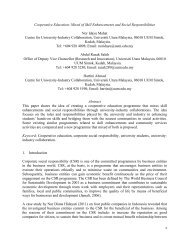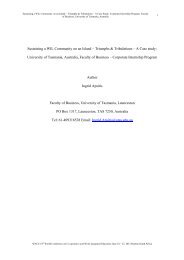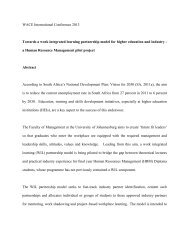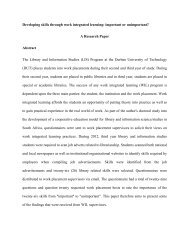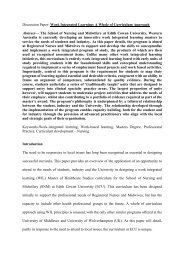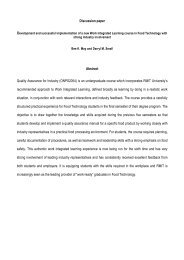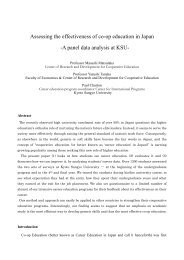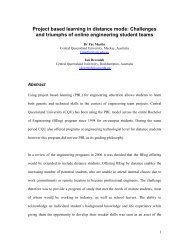(Discussion) Preparing future-fit leaders - WACE
(Discussion) Preparing future-fit leaders - WACE
(Discussion) Preparing future-fit leaders - WACE
You also want an ePaper? Increase the reach of your titles
YUMPU automatically turns print PDFs into web optimized ePapers that Google loves.
Jane Spowart<br />
Faulty of Management<br />
University of Johannesburg<br />
South Africa<br />
jspowart@uj.ac.za<br />
<strong>Discussion</strong> paper<br />
Abstract<br />
<strong>Preparing</strong> <strong>future</strong>–<strong>fit</strong> <strong>leaders</strong>; the challenge of work integrated learning in the Faculty of<br />
Management in a comprehensive university.<br />
In South Africa there is considerable discussion on the introduction of work-integrated learning<br />
(WIL) in university programmes. This would prepare graduates for the challenges of the world<br />
of work. It would also support students from diverse backgrounds to be knowledgeable and<br />
skilled, to be responsible citizens and have the ability to be employed (CHE, 2011).<br />
The University of Johannesburg (UJ) is six years old. It is a comprehensive university; the result<br />
of the merger between a Technikon and a traditional university. Most vocational programmes in<br />
the former Technikon included compulsory work-integrated learning. In the traditional university<br />
this was not the case except in the professional programmes such as nursing and teaching. In the
Faculty of Management (FoM), one of nine faculties in the UJ, there is a fairly even mix of<br />
vocational and traditional programmes.<br />
In the last three to four years, the FoM Departmental heads have been encouraged to integrate<br />
any form of work integrated learning into their programmes in order to prepare the students to be<br />
<strong>future</strong>-<strong>fit</strong> <strong>leaders</strong> for the world of work. This discussion paper will reflect on what has been<br />
achieved in the FoM by way of introducing WIL, primarily into the traditional programmes.<br />
Reference will also be made to the numerous reasons why there is resistance to this but on the<br />
other hand how others have taken up the challenge.<br />
Key words: Comprehensive University, Faculty of Management, Work integrated learning,<br />
World of Work.<br />
Introduction<br />
In South Africa many of the Universities of Technology (UoT) (similar to a polytechnic) are<br />
introducing compulsory work-integrated learning (WIL) into university programmes. This would<br />
support all students, but particularly those from rural areas who have not been exposed to the<br />
economic centers in the country. Students from diverse backgrounds would be knowledgeable,<br />
responsible citizens and prepared for the challenges of the world of work by improving their<br />
employability skills (CHE, 2011; Fallows and Stevens, 2000). There is a serious need for skilled<br />
people in South Africa but many graduates are unable to find jobs.<br />
The Ministry of Higher Education and Training is advised by the Council for Higher Education<br />
(CHE). The Higher Education Quality Committee (HEQC) is the division responsible to the<br />
CHE for quality assurance and promotion in higher education (CHE, 2011). The Council of
Higher Education describes WIL as “fostering university learning that is less didactic and more<br />
situated, participative and ‘real world ‘oriented” (CHE, 2011:4).<br />
The University of Johannesburg (UJ) is a comprehensive university and six years old. It is the<br />
result of the merger in 2005 between the former Technikon Witwatersrand (TWR), the Rand<br />
Afrikaans University (RAU) a traditional Afrikaans university and the Soweto and East Rand<br />
campuses of Vista University. It’s unique academic architecture reflects a comprehensive range<br />
of learning programmes, leading to a variety of qualifications, from vocational (diplomas) and<br />
traditional academic (degrees) to professional and postgraduate (UJ website, 2012). Although the<br />
UJ merger is now several years ago, it has had an important impact on the Faculty of<br />
Management (FoM). The Faculty is one of the most complex in the UJ as in nearly all of the<br />
eight departments there is a range of offerings of both the vocational diplomas and traditional<br />
BCom/BA degrees, as well as post-graduate masters and PhD degrees. These offerings provide<br />
prospective students with opportunities to select from a wide range of programmes which can<br />
culminate in a doctorate, should all the necessary criteria for admission be met.<br />
In the FoM, one of nine faculties in the UJ, there is a fairly even mix of vocational and<br />
traditional programmes. The Departments in the Faculty include Applied Information Studies,<br />
Business Management (including Entrepreneurship), Industrial Psychology and People<br />
Management, Information Knowledge Management, Marketing Management, Transport and<br />
Supply Chain Management and the School of Tourism and Hospitality. It should be noted that<br />
there are no finance, accounting or economic courses as these are housed in a sister Faculty of<br />
Financial and Economic Sciences due to there being approximately 10000 students in each<br />
faculty.
In the former Technikon programmes it was compulsory to have work-integrated learning (WIL)<br />
as a component of the curriculum. On the other hand most of the traditional degree programmes<br />
did not include any form of WIL or work-integrated learning except for those professional<br />
degree programmes such as law, education, medicine and nursing (Brown, 2010). There is no<br />
reason besides numerous challenges why traditional degree offerings in the FoM should not<br />
introduce a form of WIL, given the relatively wide CHE definition of this (CHE, 2011:4; South<br />
Africa, 2002). This definition states “WIL is used as an umbrella term to describe curricular,<br />
pedagogic and assessment practices across a range of academic disciplines that integrate formal<br />
learning and workplace concerns.” It goes on to “the integration of theory and practice in student<br />
learning can occur through a range of WIL approaches, apart from formal or informal work<br />
placements.”<br />
Literature study<br />
In South Africa, a developing country, the unemployment rate is 23.9% in the fourth quarter of<br />
2011 (http://www.tradingeconomics.com, 2012). One way to address this is to develop students<br />
with good work ethics and suitable work attributes by fostering university learning that is not so<br />
didactic but rather based on the real world of work (CHE, 2011). It is thought that university<br />
graduates would be able to find employment but there are many who do not (Ntuli, 2007). The<br />
skills challenges that South Africans experience can be addressed by HEIs introducing a form of<br />
WIL into all curricula, similar to the Australian concept where WIL is seen as an opportunity to<br />
improve the work-readiness of all graduates, even in non-traditional programmes (McLennan &<br />
Keating, 2008). There are approximately 600 000 unemployed arts, humanities and social<br />
science university graduates at present in South Africa but the private sector has 800 000
vacancies in management, law, engineering, finance, medicine (Roberts, 2012). This mismatch<br />
could be due to the subject choices at school. It seems absurd that a country with a high<br />
unemployment rate has graduates without work, and that professionals need to be imported or<br />
attracted to the country.<br />
This situation may arise from the fact that students lack employability skills and work-readiness,<br />
even though they may have the theoretical or technical skills required for the world of work<br />
(Crebert, Bates, Bell, Patrick & Cragnolini, 2004; Hind, Moss & McKellan, 2007). Behavioural<br />
(soft) skills such as those achieved through curricula that embed critical outcomes such as<br />
communication skills, teamwork, organize and manage oneself, usually deliver more competent<br />
and employable graduates (Coll & Zegwaard, 2006; Hind et al., 2007; Maher & Graves, 2007).<br />
Employers have indicated that students are often not prepared for the workplace and call on<br />
universities to produce more employable graduates (Barrie, 2006; Kember & Leung, 2005) by<br />
providing transferable skills that can be taken into the workplace (Smith, Clegg, Lawrence &<br />
Todd, 2007). Employers are expecting graduates to be work-ready and demanding a range of<br />
competencies and qualities of them (Yorke & Harvey, 2005). Educational institutions should be<br />
critical of their programme offerings and question if they are nurturing the appropriate<br />
competencies and consider how best to ensure these are developed (Kember & Leung, 2005).<br />
In a competitive and challenging environment, graduates need to have a good attitude towards<br />
their own responsibility of ensuring their employability skills and potential for a successful<br />
career (Maher & Graves, 2007). WIL programmes have been used successfully for this purpose<br />
(Freudenberg, Brimble & Vyvyan, 2010) and can be used as a pathway for work-readiness<br />
(McLennan & Keating, 2008).
Students’ subject matter knowledge is usually satisfactory (Crebert, et al., 2004; Hind., 2007) but<br />
by improving and developing their competencies such as interpersonal skills, teamwork,<br />
communication and problem solving skills, value will be added to their intellectual capabilities<br />
making them more employable (Freudenberg, et al., 2010; Hind et al., 2007; Maher & Graves,<br />
2007). Sometimes, employers are critical of the shortcomings of graduates but this is not<br />
necessarily due to the inappropriateness of the curriculum but rather a matter of failure in the<br />
transfer process of theory to real world requirements in a job situation (Crebert, et al., 2004). The<br />
time spent in real life situations gives students the opportunity to apply abstract concepts learnt<br />
in the classroom and achieve effective learning by transferring this knowledge to the real world<br />
where practical application takes place. The University of Cincinnati reports that the popular<br />
belief that WIL links theory and practice by reinforcing things learned in the classroom within<br />
the context of work to be far more and that the effects go beyond the scope of the curriculum.<br />
Students are exposed to much more complex life situations than can ever be covered in the<br />
classroom (Cedercreutz & Cates, 2010). In Australia there have been clear recommendations to<br />
emphasise the role that WIL can play in advancing employability skills in higher education<br />
(McLennan & Keating, 2008).<br />
Work-integrated learning refers to the linking of learning to the work role, provided by<br />
appropriate on- and off-job opportunities for training and learning. It is also referred to as a<br />
formalised educational programme supervised by the faculty of an educational institution, and<br />
takes place in a real work related environment (Wessels, 2005). As WIL programmes can vary so<br />
much, it is useful to use the term WIL as this refers to structured programmes that integrate<br />
theory and practical and not necessarily require actual work in the work place (McLennan &<br />
Keating, 2008).
The pressing need of having graduates work-ready increases the need for higher education<br />
institutions to expand the number of WIL opportunities (Harris, Jones & Coutts, 2010). The<br />
Australian higher education community has increasingly adopted WIL as a valid pedagogy in<br />
order to respond to the needs of employers for work ready graduates (Brown, 2010; McLennan<br />
& Keating, 2008). Higher Education institutions that have a reputation for providing students<br />
with a good basic theoretical and practical grounding together with WIL enhance the<br />
employability of their students (Reddan, 2008). Research has shown that the starting salaries of<br />
graduates have been influenced by their work experience obtained during the degree or diploma<br />
studies (Freudenberg et al., 2010).<br />
WIL is a collaborative arrangement and is dependent on the meaningful interaction of the three<br />
role players: the employer (industry mentor) who provides training, the academic supervisor<br />
from the HEI and the student. All three parties play a role in the success of the training<br />
experience (Bell, (SD); Orrell, 2004; Stanley, 2005). Procedures for placement of students for<br />
WIL include the evaluation of the work place as suitable for the required training, the ability of<br />
the industry mentor to supervise the training, and the willingness of the industry staff to have a<br />
student for a period of learning. An industry mentor must take responsibility for the planning and<br />
implementation of the WIL programme, in consultation with the academic supervisor. The<br />
industry supervisor needs to guide and support the student, ensure that the activities are relevant<br />
and will add to learning while integrating the theory with the practical (Fleming and Eames,<br />
2005).<br />
Winch & Ingram (2002) refer to the opportunities created by WIL to learn on many levels by<br />
forming new networks, building new relationships, gaining new knowledge and to experience the
power of technology in a context of the working world. One of the greatest challenges in South<br />
Africa is to educate the youth, for them to have skills to enable them to find gainful employment.<br />
Many graduates cannot find work. Too many young people who should be in Further Education<br />
and Training (FET) colleges, in a learner ship or apprenticed, obtain places in higher education<br />
institutions. The result is that they take much longer to graduate or they drop out. If they were<br />
placed correctly and gained skills training including a form of WIL, these young people will be<br />
better prepared to enter the world of work.<br />
Developing countries are challenged in being able to employ graduates that suit the company.<br />
The students often lack good business sense, and have limited work or real life experiences<br />
(Gamble, Patrick & Peach, 2010). It is frequently said that WIL programmes are used to develop<br />
students’ competencies, and improve attitudes and behaviour (Freudenberg, et al., 2010). South<br />
Africa as a developing country is in need of attracting and retaining well skilled staff, especially<br />
graduates (Gamble, Patrick, & Peach, 2010). In a competitive and challenging environment,<br />
graduates need to have a good attitude towards their own responsibility of ensuring their<br />
employability skills and potential for a successful career (Maher & Graves, 2007).<br />
When students are involved in project work that is ‘real world’, the result should have<br />
meaningful outcomes for both the organisation, the staff in both the organisation and at the<br />
institution (Harris et al., 2010), as well as the students who do the research and the student<br />
‘audience’ who listen to the presentation.<br />
The large numbers of business students place a huge expense on resources, both human, time and<br />
financially. The large numbers make it difficult to be responsible for the institution to place all<br />
their students. This forces the institution to rather rely on students to find their own placements
or make use of simulated exercises. The numbers will also make mentoring extremely time<br />
consuming and expensive (Hoskyn & Martin, 2011).<br />
Consistent assessment is a concern, evaluating students in a similar way is not possible when<br />
students undertake various types of WIL which cannot be compared (Hoskyn & Martin, 2011).<br />
Mention is also made of good relationships being stretched when industry mentors are extended<br />
due to so many students being involved. In many cases, students are assessed on the submissions<br />
of portfolios, reflective diaries, assignments and reports rather than the actual work completed in<br />
the work environment. This allows for greater understanding between the HEI and business as<br />
well as building valuable bridges between the world of work and the world of academia (Hodges,<br />
2011).<br />
Good student assessment will involve industry mentors. A further problem that can be a barrier<br />
to implementation, depending on the policies in a university, is the requirement that assessment<br />
is done by a lecturer who holds a qualification equal to or one level higher than the assessment<br />
being evaluated. It is often found that the mentor actually does not comply with this requirement,<br />
but of course, their work experience should be considered as essentially useful and of bene<strong>fit</strong> to<br />
the student.<br />
Many lecturers just do not want to be involved in WIL (Rowe, 2011). They lack interest, the time<br />
or are expected to deliver on research activities rather than spending time on placing, visiting,<br />
and supporting students in the work place (Brown, 2011).<br />
<strong>Discussion</strong>
The CHE (2011:16) makes suggestions when designing curricular that four main curricular<br />
modalities for WIL, although there are alternatives and hybrids, be considered for inclusion:<br />
work-directed theoretical learning, problem-based/oriented learning, project-based learning and<br />
workplace learning. What is meant by these terms<br />
work-directed theoretical learning: theoretical subjects should be aligned with the<br />
practical or practice-based components bringing the theory and practice together in a<br />
meaningful way<br />
problem-based/oriented learning: this is rather a blended approach of pure problembased<br />
learning where the inclusion of real world scenarios for problem-based<br />
activities, assignments, projects, and so on<br />
project-based learning: learning through the use of real projects located in the world<br />
of work or a simulation of these<br />
workplace learning: students are placed in the work environment for the purposes of<br />
learning.<br />
Within these generic concepts, there is a range of different approaches and models (Brown,<br />
2010). These can include those mentioned above as well as internships, work-integrated learning,<br />
field work, workplace research, and practicums amongst others.<br />
In 2009, the FoM made an important commitment to increasing the involvement of a form of<br />
WIL in all undergraduate programmes in the Faculty. This can include sustainable communityengagement<br />
as well as service-learning projects by engaging with the local communities. It is<br />
recommended that whatever form, how big or how small a section of any module that some form<br />
of assessment takes place.
The Faculty took the decision to encourage the introduction of a form of WIL into each under<br />
graduate programme, whether a diploma or degree. This could include inviting guest lecturers,<br />
use of case studies, projects in conjunction with businesses, simulation of the work place, and<br />
actual practical applications on site such as preparing and serving meals to guests at the Hotel<br />
School. The departments were encouraged to arrange for all final year under graduate students to<br />
attend three workshops presented by the Careers Development division of Psychological and<br />
Career Development (PsyCaD) on career preparation, viz preparing your CV, interviewing skills<br />
and job search skills.<br />
A brief overview follows of some of the more successful but diverse types of WIL that have<br />
either been introduced or sustained in programmes in the FoM:<br />
In the School of Tourism and Hospitality (STH) the curricula of the National Diplomas (ND) of<br />
Tourism Management and Hospitality Management have always included WIL. The latter<br />
programme is considered the benchmark of WIL in the Faculty. Students spend six months in the<br />
industry. Placements are found for them, they are visited, mentored and assessed, and this takes<br />
place in the last semester before graduation. Students receive a small remuneration but<br />
opportunities for full time work often do result as a direct result of students being involved in<br />
WIL.<br />
In the ND Small Business Management an interesting WIL concept is used. The students have a<br />
year to develop a small business in a local community without any financial inputs. They must<br />
realise a pro<strong>fit</strong> and report on the success of their projects. Unfortunately the success of students<br />
after the compulsory six months has not been recorded and tracked but will be in <strong>future</strong>. Some of
these small business projects may be considered service-learning (SL) when the student delivers<br />
an outcome in a community environment.<br />
The BCom Honours Marketing Management students have a six month internship following the<br />
year of on-campus modules extending this to an eighteen month programme. This has been very<br />
successful but it has extended the length of the programme beyond the twelve months, which<br />
may disadvantage students time-wise but all students are offered employment as a direct result of<br />
this training.<br />
The Direct Sales Association (DSA) of SA is the industry partner with the Department of<br />
Marketing Management. The ND Marketing Management students have to do practical sales as<br />
part of their Personal Selling module. The students are introduced to the products at a project day<br />
where they interact with the suppliers who exhibit the range of products. The students are set a<br />
financial turnover target to pass the module. Each week the sales persons from the various<br />
companies are on campus to offer training and question-and-answer sessions to assist the<br />
students. The students receive an incentive of a percentage as a commission. The total sales turnover<br />
during 2011 for the project was R3.3 Million (approx $412 500) in 2011 amongst 810<br />
students. A total of R760 000 ($95000) as commission was paid back to the students. The UJ<br />
team has been internationally awarded twice for the success of the project and instrumental in<br />
rolling this out in other UoTs. .<br />
Although WIL is not a prerequisite to obtain the Diploma in Information Technology, the final<br />
year students participate in projects where the top teams present to industry judges. In 2011 two<br />
of the diploma 3 rd year projects were chosen to participate at the local finals, known as the<br />
Microsoft Imagine Cup. It is the world’s premier student technology competition. Eligible
students had to use their imagination and passion to create a technology solution that addresses<br />
the Imagine Cup 2012 theme: “Imagine a world where technology helps solve the toughest<br />
problems”. In ten years, the Imagine Cup has grown to be a truly global competition focused on<br />
finding solutions to real-world problems. Since 2003, over 1.4 million students have participated<br />
in this competition with 358,000 students representing 183 countries and regions registering for<br />
the Imagine Cup 2011 competition.<br />
The BCom Information Knowledge Management programme includes projects done in<br />
conjunction with industry. At the beginning of the academic year the lecturers and invited<br />
industry members decide on projects which the students then have to research. At the end of the<br />
semester, the students are judged by the lecturers, shortlisted and the finalists must then present<br />
to a panel of business experts. The students must dress in business attire for the presentations.<br />
This is a learning activity to teach them to dress correctly for an interview in the real world of<br />
work. The panel then selects the top three teams. Students who need to present these projects<br />
improve their oral presentation skills. They receive prizes and are acknowledged within the<br />
Department.<br />
Work-integrated learning is not necessarily the perfect idea for degree programmes (Lester &<br />
Costley, 2010). WIL has not been on the radar of traditional university programmes nor has it<br />
been at the fore-front of industry players as student learning is not their core business (Harris et<br />
al., 2010). However, the Faculty of Management is preparing <strong>future</strong>-<strong>fit</strong> graduates. One of the<br />
Faculty’s thrusts is to strengthen and enhance quality interactions between industry partners and<br />
the university, nurture new partnerships while sustaining those already in place. WIL can provide<br />
opportunities to develop working partnerships that are mutually respectful of the capabilities and
developmental potential of both partner organisations and student body (Gamble, et al., 2010;<br />
Harris, et al., 2010).<br />
Feedback from Departments as to their reluctance to increase WIL includes major challenges<br />
such as the difficulties of finding appropriate placements for so many students (Brown, 2010), it<br />
is time-consuming, the lack of sufficient resources to support visits, academic work overload and<br />
administratively managing a WIL programme (Freudenberg, et al., 2010; Harris, et al., 2010) are<br />
cited as reasons why Departments do not embrace the concept. With the intense focus on<br />
improving staff qualifications and increasing research outputs, staff does not have the inclination<br />
to expend energy on including WIL in their programmes, even though there are distinct bene<strong>fit</strong>s<br />
for students.<br />
In order to have successful implementation, it is necessary that an institution–wide position on<br />
WIL is supported by policy (Brown, 2010). In the UJ it has been difficult to convince senior<br />
management that serious consideration should be given to the inclusion of WIL in all under<br />
graduate programmes. In student meetings, their request is for this type of ‘real-world’ learning<br />
(Brown, 2010; Harris et al., 2010) as they realise the advantage of working in industry prior to<br />
graduation, with the possibility of obtaining work employment immediately on completion of<br />
their studies.<br />
Conclusions and implications<br />
Living in such a diverse cultural society, graduates from South Africa should have an advantage<br />
for employment in international organisations if they use their skills to cope with change<br />
(Gamble, et al., 2010). The general agreement is that WIL should be incorporated into degree
programmes in order to ensure students gain generic, employability skills such as<br />
communication, teamwork, problem-solving, initiative, planning and organizing, selfmanagement<br />
and technology learning (Brown, 2010; Freudenberg, Brimble, & Cameron. 2010.)<br />
Research undertaken by Freudenberg et al., (2010) realised that WIL has had a positive impact<br />
on students’ learning, the presence of industry representatives together with their involvement in<br />
projects and presentations, motivates students to work harder and prepare work of a better<br />
standard (Freudenberg et al., 2010). Involved academics will experience interaction with industry<br />
making them aware of the current business environment as well as having better engaged<br />
students, improved success rates and a sense of satisfaction due to the employability and<br />
employment of students.<br />
With the wide variety of programmes offered in the Faculty of Management, it will not be<br />
possible to ‘dictate’ as to what type of WIL should be integrated into the curriculum but it should<br />
be left to the decision of the experts in the field. The large number of students in the business<br />
field of studies causes additional pressures to the encouragement of introducing this on a wide<br />
scale (Hoskyn & Martin, 2011). However it is essential that higher education be responsible to<br />
provide its graduates with the skills to operate professionally within the business environment<br />
(Vignali & Hodgson, 2007).<br />
Another bene<strong>fit</strong> of WIL programmes is the possibility of enhancing and providing a sustainable<br />
competitive advantage that is a vital part of the academic strategy (Cedercreutz & Cates, 2010)<br />
and the educational standing of the institution. The success of any programme is dependant on<br />
the attitudes of the parties involved, in particular the academic staff and the students (Rowe<br />
2011). Students in the USA (Rowe, 2011) have been known to select the university that they
attend on the strength of the WIL programmes, providing the opportunity to gain work<br />
experience and resulting in job offers. However, criticism is leveled at the lecturers who lack<br />
knowledge and skills needed in the workplace (Rowe, 2011). Lack of appropriate jobs is a major<br />
problem as well as the staff who lack interest, lack time or even the ability to seek out<br />
placements for the students.<br />
There are many challenges, but the opportunities that can be learnt from other higher education<br />
institutions when WIL is embedded into curricula (Brown, 2011) should be studied. Other<br />
challenges include finding suitable WIL opportunities, maintaining partnerships with business,<br />
especially when mentors resign and move on elsewhere. It is also a positive opportunity to<br />
include research initiatives into the WIL component, especially where WIL is included in postgraduate<br />
programmes. This will add a scholarly edge to the programmes (Brown, 2011). WIL<br />
requires academics who are not accustomed to this form of pedagogy to adapt to a different<br />
teaching and learning context, especially those who work in a traditional university environment<br />
(McLennan & Keating, 2008). Training for staff that is new to this should be supported by<br />
academic development programmes and should be recognised and rewarded for their<br />
contribution of their work in this area. Convincing staff to add this to their already busy<br />
schedules is a battle.<br />
There is some evidence of UoTs and comprehensive universities experiencing mission drift from<br />
the diplomas toward offering more degree programmes due to the perceived recognition of<br />
graduating with a degree, rather than with a diploma (Higher Education and Training, 2012).<br />
This could lead to a greater number of students not being exposed to WIL with the obvious<br />
consequences, if the degree programmes do not have WIL integrated into the curricula. WIL
integrates campus life with business and civic community in a very effective way (Cedercreutz &<br />
Cates, 2010). This would impact on the development of <strong>future</strong>-<strong>fit</strong> graduates, could provide a<br />
definite edge to the FoM being chosen as the preferred provider of students for their further<br />
studies.<br />
Bibliography<br />
Barrie, S.C. (2006). Understanding what we mean by the generic attributes of graduates. Higher<br />
Education, 51: 215-241.<br />
Bell, B. (SD). WIL for one, WIL for all; an Australian case study. Grif<strong>fit</strong>hs University<br />
Brown, N. (2010). WIL[ling] to share: an institutional conversation to guide policy and practice<br />
in work-integrated learning. Higher Education Research & Development, 29(5): 507-518.<br />
Cedercreutz, K. & Cates, C. (2010). Cooperative education at the University of Cincinnati: A<br />
strategic asset in evolution. AAC &U peer review, Fall: 20-23.<br />
Coll, R. & Zegwaard, K.E. (2006). Perceptions of desirable graduate competencies for science<br />
and technology new graduates. Research in Science & Technological Education, 24(1):<br />
29-58.<br />
Council on Higher Education (CHE). (2011). Work-Integrated learning: Good Practice Guide,<br />
HE Monitor No. 12, August, 2011.<br />
Crebert, G., Bates, M., Bell, B., Patrick, C-J. & Cragnolini, V. (2004). Ivory tower to Concrete<br />
Jungle Revisited. Journal of Education and Work, 17(1): 47-70.<br />
Fallows, S. & Steven, C. (2000). Building employability skills in the higher education<br />
curriculum: a university-wide initiative. Education &Training, 42(2): 75-82.
Fleming, J. & Eames, C. (2005). Student Learning in Relation to the Structure of the Cooperative<br />
Experience. Asia-Pacific Journal of Cooperative Education, 6(2): 26-31.<br />
Freudenberg, B., Brimble, M. & Cameron C. (2010). Where there is a WIL there is a way.<br />
Higher Education Research & Development, 29(5): 575-588.<br />
Freudenberg, B., Brimble, M. & Vyvyan, V. (2010). The Penny drops: Can Work Integrated<br />
Learning Improve Students’ learning e-Journal of Business education & Scholarship of<br />
Teaching, 4(1): 42-61.<br />
Gamble, N., Patrick, C.J. & Peach, D. (2010). Internationalising work-integrated learning:<br />
creating global citizens to meet the economic crisis and the skills shortage. Higher<br />
Education Research & Development, 29(5): 535-546.<br />
Harris, L., Jones, M. & Coutts, S. (2010). Partnerships and learning communities in workintegrated<br />
learning: designing a community services student placements program. Higher<br />
Education Research & Development, 29(5): 547-559.<br />
Higher Education and Training (2012). Green Paper for Post-School Education and Training.<br />
Republic of South Africa.<br />
Hind, D., Moss, S. & McKellan, S. (2007). Innovative Assessment Strategies for developing<br />
Employability Skills in the Tourism and Entertainment Management Curriculum at Leeds<br />
Metropolitan University. Paper presented at the 2007 EuroCHRIE Conference, Leeds,<br />
UK.<br />
Hodges, D. (2011). Assessment of student learning in cooperative education. In Coll, R. K. &<br />
Zegwaard, K. E. (Eds.).International handbook for cooperative and work-integrated<br />
education. 2nd ed. Lowell, M.A., World Association for Cooperative Education: 53-62.
Hoskyn, K & Martin, A. (2011). Cooperative and work-integrated education in Business. In Coll,<br />
R. K. & Zegwaard, K. E. (Eds.).International handbook for cooperative and workintegrated<br />
education. 2nd ed. Lowell, M.A., World Association for Cooperative<br />
Education: 173-178.<br />
http://www.tradingeconomics.com/south-africa/unemployment-rate accessed 11 February 2012<br />
Kember, D. & Leung, D.Y.P. (2005). The Influence of the Teaching and Learning Environment<br />
on the Development of Generic Capabilities needed for a Knowledge-based Society.<br />
Learning Environments Research, 8: 245-266.<br />
Lester, S. & Costley, C. (2010). Work-based learning at higher education level: value, practice<br />
and critique. Studies in Higher Education, 35(5): 561-575.<br />
Maher, A. & Graves, S. (2007). Making students more employable: can higher education<br />
deliver Paper presented at the 2007 EuroCHRIE Conference, Leeds, UK.<br />
McLennan, B. & Keating, S. (2008). Work-integrated Learning (WIL) in Australian universities:<br />
the challenges of mainstreaming WIL. ALTC NAGCAS National Symposium, June 2008,<br />
Melbourne.<br />
Ntuli, D. (2007). Graduates fail by degrees. Business Times Careers, April 1.<br />
Orrell, J. (2004). Work-integrated Learning programmes: Management and Educational Quality.<br />
Proceedings of the Australian Universities Quality Forum.<br />
Reddan, G. (2008). The bene<strong>fit</strong>s of job-search seminars and mock interviews in a work<br />
experience course. Asia-Pacific Journal of Cooperative Education, 9(2): 113-127.<br />
Roberts, J. (2012). Little desire to work in SA. Business Times, 11 th January.<br />
Rowe, P.M. (2011). Cooperative and work-integrated education in graduate programmes. In<br />
Coll, R. K. & Zegwaard, K. E. (Eds.).International handbook for cooperative and work-
integrated education. 2nd ed. Lowell, M.A., World Association for Cooperative<br />
Education: 331-335.<br />
Smith, K., Clegg, S., Lawrence, E. & Todd, M.J. (2007). The challenges of reflection: students<br />
learning from work placements. Innovations in Education and teaching International,<br />
44(2): 131 -141.<br />
South Africa. (2002). New academic policy for programmes and qualifications in higher<br />
education. Pretoria, South Africa: Government printer.<br />
Stanley, M. (2005). Co-operative Education: an effective educational strategy. Journal for New<br />
Generation Sciences, 3(2): 105-115.<br />
Vignali, G. & Hodgson, I. (2007). Real World Learning-Enhanced Employability. Paper<br />
presented at the 2007 EuroCHRIE Conference, Leeds, UK.<br />
Wessels, M. (2005). Experiential Learning. Juta and Co. Lansdowne, South Africa.<br />
Winch, A. & Ingram, H. (2002). Re-defining the focus of workplace learning. International<br />
Journal of Contemporary Hospitality Management, 14(7): 361-367.<br />
Yorke, M. & Harvey, L. (2005). Graduate Attributes and Their Development. New Directions for<br />
Institutional Research, 128: 41-58.



